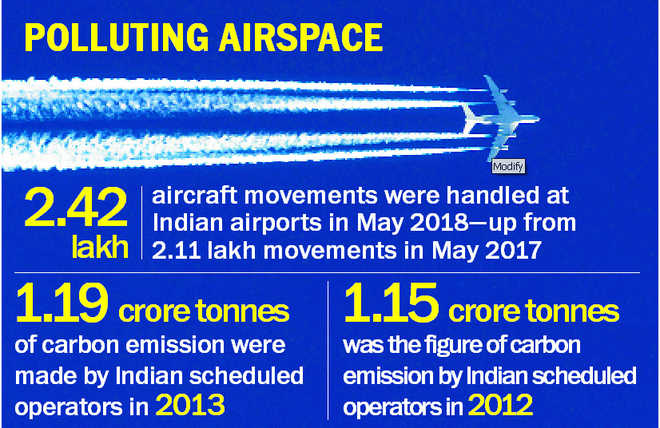
Vijay Mohan
Tribune News Service
Chandigarh, July 18
The Directorate General of Civil Aviation (DGCA) has drafted a policy to fix carbon dioxide emission norms and test procedure for aircraft.
The draft has been circulated among stakeholders for comments and suggestions. All jet aeroplanes having a maximum take-off weight above 5,700 kg and all propeller-driven aircraft having a maximum take-off weight above 8,618 kg would have to comply with emission norms.
Amphibious aircraft and those designed or modified for special operational requirements, including fire-fighting, however, are exempted.
Different emission standards have been set for various categories of aircraft depending on their weight, speed, payload, operating altitude, atmospheric conditions, engine power and type of fuel used.
Emission certification for pre-flight as well as in-flight configuration will be granted or validated by the DGCA on the basis of satisfactory evidence that the aeroplane complies with requirements similar to the applicable standards specified in the policy.
The policy assumes significance in the backdrop of India emerging as the world’s third largest civil aviation market. According to DGCA data, there are 15 scheduled aircraft operators in India as of May 2018, operating 593 aircraft that fall into the policy’s purview.
There are 111 non-scheduled and numerous private operators. Reports say India is expected to order over 1,600 aircraft over the next 20 years. In May 2018, Indian airports handled over 2.42 lakh aircraft movements as compared to about 2.11 lakh in May 2017.
Carbon dioxide emission factor for aviation turbine fuel (ATF) is the highest as compared to fuels like petrol, CNG, LPG and electricity. In India, the aviation sector accounts for about 1 per cent of the total anthropogenic emissions, which is lower than the global average.
According to the DGCA data, carbon emissions of Indian scheduled passenger airlines for domestic and international destinations in 2013 stood at 11,950,000 tonnes — a 3.37 per cent increase compared to the 11,560,000 tonnes in 2012. On the other hand, emissions by foreign scheduled airlines flying to India reduced by 3.91 per cent for the same period. Several Indian operators have introduced measures like use of fuel-efficient engines, reducing the number and weight of onboard service items and revising on-ground and in-flight operating procedures to cut fuel consumption and emissions.



























